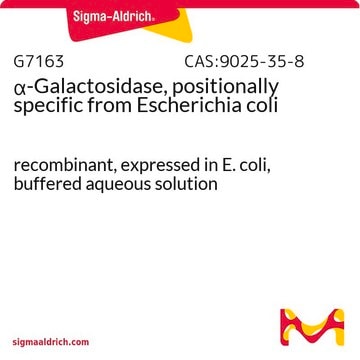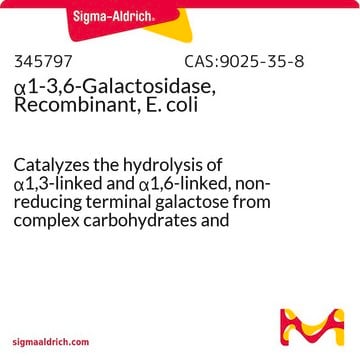推薦產品
重組細胞
expressed in E. coli
化驗
≥85% (SDS-PAGE)
形狀
lyophilized solid
比活性
≥20 units/mg protein
分子量
apparent mol wt ~84 kDa by SDS-PAGE
運輸包裝
wet ice
儲存溫度
−20°C
一般說明
Alkaline α-Galactosidase I is a glycoside hydrolase, separated from the extracts of melon fruits. The activity of this enzyme is found to increase during the early stages of ovary development and fruit set.[1]
應用
Alkaline α-Galactosidase I was used to assay enzyme activity with 2 mmp-nitrophenyl-α-d-galactoside as substrate at pH 6.5 to compare with the enzyme activity of α-Gal A isolated and purified from Sf-9 insect cells infected with a recombinant baculovirus encoding normal α-Gal A gene.[2]
生化/生理作用
α-Galactosidase form I from melon may play a significant role in photoassimilate partitioning in sink tissue. The form I enzyme has a preferred activity with raffinose and significant activity with stachyose. A unique feature of this enzyme is that it exhibits weak product inhibition by galactose.
This enzyme shows a preference for raffinose and also activity with stachyose. Unlike other a-Galctosidases, this enyzme also shows weak inhibition by galactose.
物理性質
This enzyme exhibits maximal activity between 30-37°C. Activity declines above 40°C.
單位定義
One unit will hydrolyze 1.0 μmole of p-nitrophenyl α-D-galactoside to p-nitrophenol and D-galactose per minute at pH 7.8 at 30 °C.
外觀
The product is supplied as a lyophilized powder containing Tris-HCl buffer salts, DTT, EDTA, and NaCl.
訊號詞
Warning
危險聲明
危險分類
Eye Irrit. 2 - Skin Irrit. 2 - STOT SE 3
標靶器官
Respiratory system
儲存類別代碼
11 - Combustible Solids
水污染物質分類(WGK)
WGK 3
閃點(°F)
Not applicable
閃點(°C)
Not applicable
N Asano et al.
European journal of biochemistry, 267(13), 4179-4186 (2000-06-24)
Fabry disease is a lysosomal storage disorder caused by deficient lysosomal alpha-galactosidase A (alpha-Gal A) activity. Deficiency of the enzyme activity results in progressive deposition of neutral glycosphingolipids with terminal alpha-galactosyl residue in vascular endothelial cells. We recently proposed a
Gao et al.
Plant physiology, 119(3), 979-988 (1999-03-09)
The cucurbits translocate the galactosyl-sucrose oligosaccharides raffinose and stachyose, therefore, alpha-galactosidase (alpha-D-galactoside galactohydrolase, EC 3.2.1.22) is expected to function as the initial enzyme of photoassimilate catabolism. However, the previously described alkaline alpha-galactosidase is specific for the tetrasaccharide stachyose, leaving raffinose
Nir Carmi et al.
The Plant journal : for cell and molecular biology, 33(1), 97-106 (2003-08-29)
Raffinose and stachyose are ubiquitous galactosyl-sucrose oligosaccharides in the plant kingdom which play major roles, second only to sucrose, in photoassimilate translocation and seed carbohydrate storage. These sugars are initially metabolised by alpha-galactosidases (alpha-gal). We report the cloning and functional
Antonio Pisani et al.
Molecular genetics and metabolism, 107(3), 267-275 (2012-09-12)
Anderson-Fabry disease is an X-linked lysosomal storage disorder resulting from the deficiency of the hydrolytic enzyme alpha galactosidase A, with consequent accumulation of globotrioasoyl ceramide in cells and tissues of the body, resulting in a multi-system pathology including end organ
Multicomponent nanoparticles as nonviral vectors for the treatment of Fabry disease by gene therapy.
Aritz Pérez Ruiz de Garibay et al.
Drug design, development and therapy, 6, 303-310 (2012-11-03)
Gene-mediated enzyme replacement is a reasonable and highly promising approach for the treatment of Fabry disease (FD). The objective of the present study was to demonstrate the potential applications of solid lipid nanoparticle (SLN)-based nonviral vectors for the treatment of
Active Filters
我們的科學家團隊在所有研究領域都有豐富的經驗,包括生命科學、材料科學、化學合成、色譜、分析等.
聯絡技術服務








